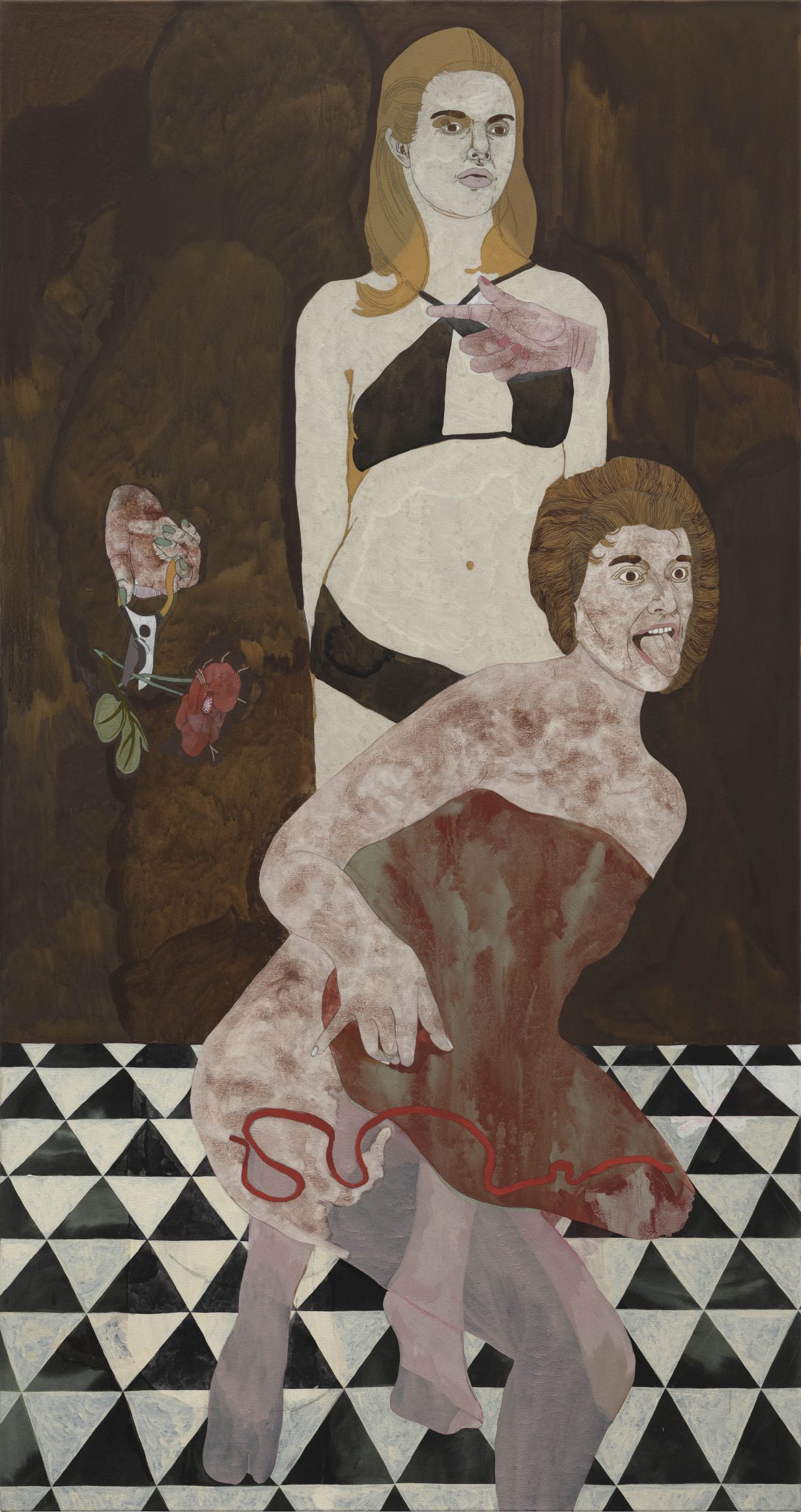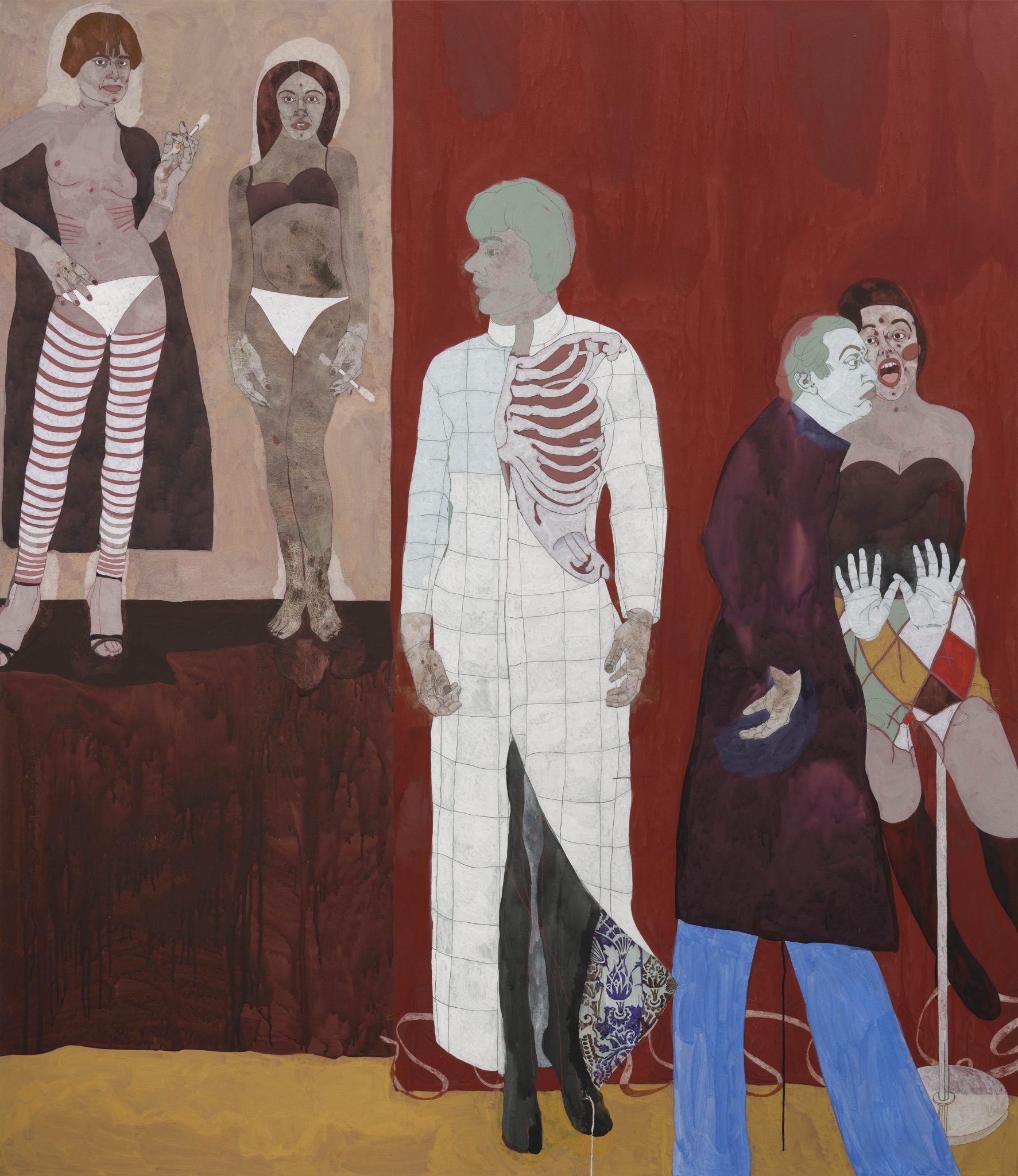Unconstrained by the patriarchal imagination, Walker’s women in The Romance of the Rose at Pilar Corrias, London threaten to rework the rulebook
Like Caryl Churchill’s seminal feminist play Top Girls (1982), Ella Walker’s paintings feature a cast of female characters apparently gathered up from farflung epochs and then transplanted to what seems to be a stage set, which sits curiously outside time. Graphically rendered, mannered of pose and often half-clothed, the women in the British artist’s work sport wimples and zippered fetish knickers, Breton stripes and harlequin’s motley, as though they’ve been rifling through the costume box of history, trying on identities and then casting them off again. Far less fluid are their faces, which have the frozen, exaggerated quality of Grecian theatre masks. In The Bridled Sweeties (all works 2024), open mouths let out silent songs, or screams. Teeth are bared and tongues protrude from parted lips.
Now and then, Walker’s figures notice they have an audience. Their eyes fix us with a tractor beam stare, or else roll back in their sockets, exasperated at our attentions. Mostly, however, they’re preoccupied with their own strange dramas. These play out in architectural interiors whose sparse fixtures and fittings (Ionic pillars, Modernist stools) feel more like scenery and props than genuine objects. Employing a shallow, almost frescolike pictorial space, Walker channels the precision of Piero della Francesca, and the eeriness of Giorgio de Chirico – witness the mathematical rigour and near-metaphysical intensity she brings to her depiction of marble inlay floors.
Walker’s show is titled after Guillaume de Lorris and Jean de Meun’s thirteenth-century French poem The Romance of the Rose (c. 1230–75), in which an amorous youth goes on a quest to ‘pluck’ the ‘perfect rosebud’ – that is, to seduce and deflower a virgin. Success depends on him mastering the conventions of chivalric love and navigating his way past a series of wearingly sexist allegorical female figures, among them Avarice, Envy and Hypocrisy. No such macho swain is present in Walker’s painted world, and it follows that the women she depicts are not constrained by the patriarchal imagination.

Contemplating these smart, often very funny paintings, one senses that roles are not only being rehearsed but also subverted; that archaic scripts are in the process of being workshopped and improved. In Caryatid, a young, crop-haired woman resembling Renée Jeanne Falconetti in the film The Passion of Joan of Arc (1928) is pictured turning her back on an anthropomorphised and decidedly phallic column, a look of vicarious embarrassment on her face. For her, the caryatid’s dedication to immobile feminine servitude is clearly as cringeworthy as it gets. Pierced with arrows, the gormless, vaguely medieval-looking nude in The Loyal Bride seems to have been struck by Cupid’s bow. And yet it’s not a husband who carries her off, but a group of gurning, cackling female figures, who we might read equally as maenads, a coven of witches and as a raucous contemporary hen party.
In Medea, the titular vengeful sorceress of Greek myth dances a frenzied jig. To her right, a floating, disembodied hand clasps a pair of secateurs, with a single cut rose suspended from its blades. Perhaps this is a warning to amorous young men. The severing of bodily extremities, after all, is an age-old punishment for those who ‘pluck’ what they should not. Behind Medea, a girl in a black bikini contemplates a second hovering hand, which points outside the frame of the image, beyond Walker’s stage. What might happen, we wonder, when her women step out into the real world?
The Romance of the Rose at Pilar Corrias, London, through 9 November
